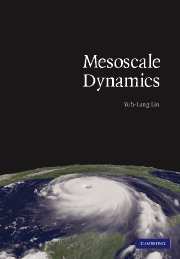Book contents
- Frontmatter
- Contents
- Preface
- 1 Overview
- 2 Governing equations for mesoscale motions
- 3 Basic wave dynamics
- 4 Mesoscale wave generation and maintenance
- 5 Orographically forced flows
- 6 Thermally forced flows
- 7 Mesoscale instabilities
- 8 Isolated convective storms
- 9 Mesoscale convective systems
- 10 Dynamics of fronts and jet streaks
- 11 Dynamics of orographic precipitation
- 12 Basic numerical methods
- 13 Numerical modeling of geophysical fluid systems
- 14 Parameterizations of physical processes
- Appendices
- Index
- References
4 - Mesoscale wave generation and maintenance
Published online by Cambridge University Press: 15 December 2009
- Frontmatter
- Contents
- Preface
- 1 Overview
- 2 Governing equations for mesoscale motions
- 3 Basic wave dynamics
- 4 Mesoscale wave generation and maintenance
- 5 Orographically forced flows
- 6 Thermally forced flows
- 7 Mesoscale instabilities
- 8 Isolated convective storms
- 9 Mesoscale convective systems
- 10 Dynamics of fronts and jet streaks
- 11 Dynamics of orographic precipitation
- 12 Basic numerical methods
- 13 Numerical modeling of geophysical fluid systems
- 14 Parameterizations of physical processes
- Appendices
- Index
- References
Summary
Introduction
In this chapter, the generation mechanisms for mesoscale waves, which include pure gravity waves, inertial oscillations, and inertia-gravity waves, will be discussed. As mentioned in Chapter 3, due to their dispersive nature, most gravity waves generated by a variety of atmospheric sources tend to lose coherence after some time. Therefore, our discussion of wave maintenance will focus on waves, such as those defined in the literature as long-lasting mesoscale waves with perturbation pressure amplitudes of 0.2–7.0 hPa, horizontal wavelengths of 50–500 km, and periods of 1–4 h (Uccellini and Koch 1987).
As they propagate away from their source region, mesoscale waves in the atmosphere may also initiate severe convective storms, generate wind gusts, and create turbulence leading to aviation safety problems. The surface pressure perturbation associated with a large-amplitude mesoscale gravity wave may even be larger than that typically associated with midlatitude cyclogenesis and often creates some confusion in weather forecasts (Fig. 4.1). This type of event might be incorrectly interpreted as the onset of secondary cyclogenesis along a coastal front, such as the case which occurred on February 27, 1984, as pointed out by Bosart and Seimon (1988). Occasionally, mesoscale waves with horizontal wavelengths of 50–500 km may last for several hours and propagate distances of several hundred kilometers to more than 1000 km away from the wave source region. This type of long-lasting mesoscale wave may behave like an isolated wave of elevation or depression, or often as a localized wave packet.
Information
- Type
- Chapter
- Information
- Mesoscale Dynamics , pp. 64 - 108Publisher: Cambridge University PressPrint publication year: 2007
